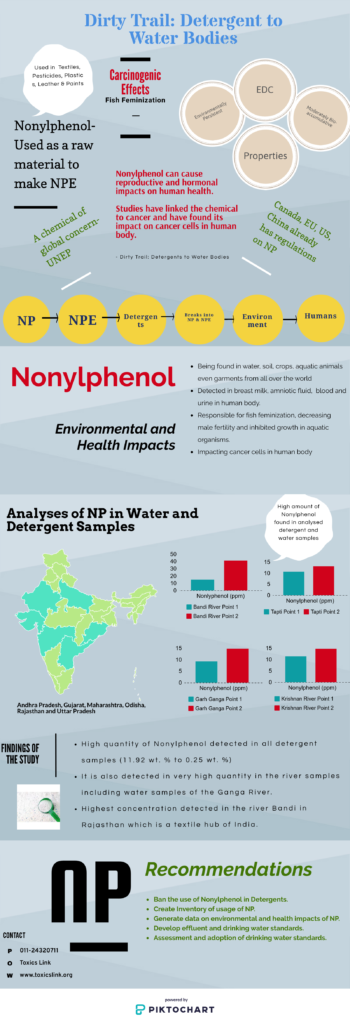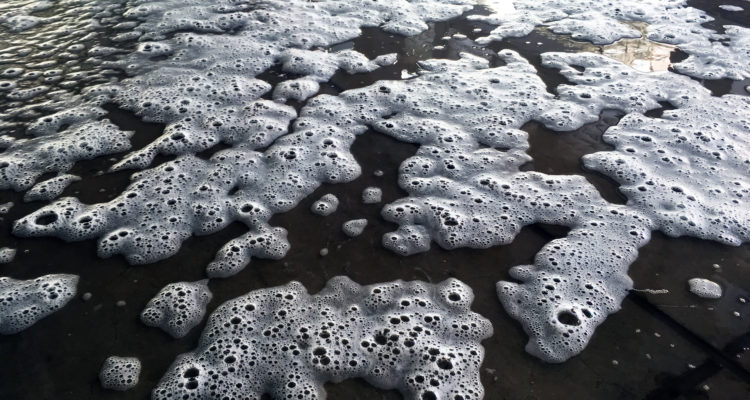◊ By Benefit Publishing Bureau
Visit ORGANIC SHOP by Pure & Eco India
A new study released by the environmental NGO, Toxics Link called ‘Dirty Trail: Detergent to water bodies’, has found alarming levels of the toxic chemical Nonylphenol (NP) in detergents, as well as, in river water in India. The 10 detergent samples were taken from the local markets of Delhi, as well as, water from 6 water bodies—the rivers Garh Ganga and Hindon in Uttar Pradesh, Krishna in Andhra Pradesh, Tapti in Gujarat, Bandi in Rajasthan, Mahanadi in Odisha and Ambazari Lake in Nagpur.
Nonylphenol was detected in high quantity in all the samples of detergent, river and lake water. The study was conducted by Toxics Link, in association with The Department of Chemical Engineering, Indian Institute of Technology, Guwahati.
“There has been no study conducted in India so far and it’s the first-of-its-kind report to bring the presence and toxicity impacts associated with Nonylphenol into the public domain. There is an urgent need for developing stringent regulations to restrict the entry of NP into the environment and human body,” says Satish Sinha, Associate Director, Toxics Link.

KEY FINDINGS OF THE STUDY
- Nonylphenol was found in high quantities in all the detergent samples. The concentration of Nonylphenol was found in detergent samples ranging from 0.25 wt% to 11.92 wt%
- Nonylphenol was detected in notably high quantities in all the river samples
- Nonylphenol concentration was found to be 14.76 ppm in Garh Ganga
- The highest level of Nonylphenol was found in the water sample from the Bandi river in Rajasthan, at 41.27 ppm
- Despite many corporations claiming that they don’t use Nonylphenol, the study confirmed the presence of high quantities of the chemical in the products sold by their Indian subsidiaries
HOW HARMFUL IS NONYLPHENOL?
Nonylphenol is known to be an endocrine disrupting chemical, which is hazardous to the environment and human health, besides also posing a threat to aquatic life and other fauna. The chemical has also been found to have a number of adverse reproductive and hormonal effects on human beings and can cause carcinogenic effects on the human body.
NONYLPHENOL IS HIGHLY REGULATED IN OTHER COUNTRIES, BUT NOT IN INDIA
Due to its harmful effects, Nonylphenol has been highly regulated by many countries globally. The United States, the European Union and even China have phased out Nonylphenol from detergent completely.
Denmark has completely banned the use of Nonylphenol Ethoxylates (NPEs) in textile and leather industries and the EU has restricted the use of NPEs in products and product formulations to 0.01% in textile and other industries.
Moreover, efforts are being made to restrict the use of the chemicals in drinking water. Canada has set the standard of Nonylphenol at 1.0 ug/L in freshwater, while the US EPA (Environmental Protection Agency) has established water quality criteria for NP at 6.6 ug/L for acute exposures and 1.7 ~lg/L for chronic exposures.
“Despite Nonylphenol being a toxic chemical, it was found in very high concentration in all the detergent samples that were tested. It is also a matter of grave concern that high concentration of Nonylphenol in river water samples can cause irreversible harm to aquatic organisms,” says Piyush Mohapatra, Senior Coordinator – Chemical and Health Programme, Toxics Link.
The BIS (Bureau of Indian Standards) has set the standard of phenolic compounds for drinking water (0.001 mg/L) and surface water (5.0 mg/L). However, unlike other countries, India does not have specific standards for Nonylphenol in drinking water and surface water.
In the Toxics Link study, the concentration of Nonylphenol was found to be as much as 8 times more than the prescribed BIS standard for phenolic compounds, and over 100 times as compared to the US EPA safety standard for water quality criteria.
RECOMMENDATIONS PROPOSED BY THE STUDY
- Banning the use of Nonylphenol in all detergents
- Creating an inventory on the usage of Nonylphenol in different sectors in the country
- Introducing standards on Nonylphenol in drinking water and in food to protect human health, as well as, the environment
- Initiating legal action against companies practising double standards, based on the polluter pays principle.



Please change the India map, or delete the map shown, if you want to represent please represent 🙏 properly. Be more sensitive.
He is correct, we cannot do anything about cancer or the river water. But atleast you guys could put the correct map of india.
In popular grade like Ghadi, nirma, fena do not use NP but use Labsa, AOS as anionic surfactant. But premium detergent product like Surf excel, Ariel etc use NP non ionic surfactants. Same is with textile . As a Chemical engineer and detergent consultant since 1980 , I feel use of phenolic surfactant should be banned. We have Glucose base surfactant which are more effective and have low critical miscille concentration value. BIS standard should be modified and upgraded as per American standards